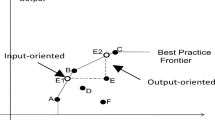Abstract
This paper examines the interplay of the financing and hedging decisions of a risk-averse multinational firm having a wholly-owned foreign subsidiary. Exchange rate risk management of the multinational firm is shown to have direct impacts on its international capital structure decision and on its currency of denomination decision. If a currency forward market exists, the multinational firm will devise its international capital structure so as to minimize the global weighted average cost of capital. Or else the multinational firm has to rely on a money market hedge through issuing more foreign currency denominated debt and less domestic currency denominated debt, thereby resulting in a higher global weighted average cost of capital.
Similar content being viewed by others
References
Altshuler, R. and P. Fulghieri (1994) “Incentive Effects of Foreign Tax Credits on Multinational Corporations.” National Tax Journal 27:349–361.
Arrow, K.J. (1965) Aspects of the Theory of Risk-Bearing. Helsinki: Yrjo Jahnsson Saatio.
Brealey, R.A. and S.C. Myers (2004) Principles of Corporate Finance (7th ed.). New York, NY: McGraw–Hill.
Broll, U. and K.P. Wong (1999) “Hedging with Mismatched Currencies.” Journal of Futures Markets 19:859–875.
Broll, U. and K.P. Wong (2002) “Imperfect Forward Markets and Hedging.” Economic Notes 31:143–154.
Broll, U., K.P. Wong, and I. Zilcha (1999) “Multiple Currencies and Hedging.” Economica 66:421–432.
Broll, U. and I. Zilcha (1992) “Exchange Rate Uncertainty, Futures Markets and the Multinational Firm.” European Economic Review 36:815–826.
Chowdhry, B. and J.D. Coval (1998) “Internal Financing of Multinational Subsidiaries: Debt vs. Equity.” Journal of Corporate Finance 4:87–106.
Danthine, J.P. (1978) “Information, Futures Prices, and Stabilizing Speculation.” Journal of Economic Theory 19:79–98.
Desai, M.A., C.F. Foley, and J.R. Hines (2004) “A Multinational Perspective on Capital Structure Choice and Internal Capital Markets.” Journal of Finance 59:2451–2487.
Elliott, W.B., S.P. Huffman, and S.D. Makar (2003) “Foreign–Denominated Debt and Foreign Currency Derivatives: Complements or Substitutes in Hedging Foreign Currency Risk?” Journal of Multinational Financial Management 13:123–139.
Froot, K.A., D.S. Scharfstein, and J.C. Stein (1993) “Risk Management: Coordinating Corporate Investment and Financing Policies.” Journal of Finance 48:1629–1658.
Giddy, I.H. (1994) Global Financial Markets. Lexington, MA: D.C. Heath and Company.
Hartman, D.G. (1985) “Tax Policy and Foreign Direct Investment.” Journal of Public Economics 26:107–121.
Hodder, J.E. and L.W. Senbet (1990) “International Capital Structure Equilibrium.” Journal of Finance 45:1495–1516.
Holthausen, D.M. (1979) “Hedging and the Competitive Firm under Price Uncertainty.” American Economic Review 69:989–995.
Katz, E. and J. Paroush (1979) “The Effect of Forward Markets on Exporting Firms.” Economics Letters 4:272–274.
Keloharju, M. and M. Niskanen (1997) “Why Do Firms Raise Foreign Currency Denominated Debt?” Working paper, Helsinki School of Economics and Business Administration.
Kraus, A. and R.H. Litzenberger (1973) “A State Preference Model of Optimal Financial Leverage.” Journal of Finance 28:911–921.
Meese, R. and K. Rogoff (1983) “Empirical Exchange Rate Models of the Seventies: Do They Fit Out-of-Sample?” Journal of International Economics 14:3–24.
Nguyen, H. and R. Faff (2004) “Foreign Debt and Financial Hedging: Evidence from Australia.” International Review of Economics and Finance, in press.
Pratt, J.W. (1964) “Risk Aversion in the Small and in the Large.” Econometrica 32:122–136.
Rhee, S.G., R.P. Chang, and P.E. Koveos (1985) “The Currency–of-Denomination Decision for Debt Financing.” Journal of International Business Studies 16:143–150.
Rogalski, R.J. and J.D. Vinso (1977) “Stock Returns, Money Supply and the Direction of Causality.” Journal of Finance 32:1017–1030.
Roll, R. (1977) “Violations of PPP and Their Implications for Efficient International Commodity Markets.” In M. Sarnat and G.P. Szego (eds.), International Finance and Trade 1:133–176.
Ross, S.A., R.W. Westerfield, and B.D. Jordan (2004) Fundamentals of Corporate Finance (6th ed.). Boston, MA: Irwin/McGraw-Hill.
Scholes, M.S. and M.A. Wolfson (1992) Taxes and Business Strategy: A Planning Approach. Englewood Cliffs, NJ: Prentice Hall.
Scott, J.H. (1976) “A Theory of Optimal Capital Structure.” Bell Journal of Economics and Management Science 7:33–54.
Shapiro, A.C. (1984) “The Impact of Taxation on the Currency of Determination Decision for Long-Term Foreign Borrowing and Lending.” Journal of International Business Studies 15:15–25.
Smith, C.W. and R.M. Stulz (1985) “The Determinants of Firms' Hedging Policies.” Journal of Financial and Quantitative Analysis 20:391–405.
Stulz, R.M. (1984) “Optimal Hedging Policies.” Journal of Financial and Quantitative Analysis 19:127–140.
Stulz, R.M. (1990) “Managerial Discretion and Optimal Financial Policies.” Journal of Financial Economics 26:3–27.
Author information
Authors and Affiliations
Corresponding author
Additional information
JEL Classification Numbers: D81, F23, G32
Rights and permissions
About this article
Cite this article
Broll, U., Wong, K.P. Multinationals, Hedging, and Capital Structure under Exchange Rate Uncertainty. Open Econ Rev 17, 103–114 (2006). https://doi.org/10.1007/s11079-006-4744-x
Issue Date:
DOI: https://doi.org/10.1007/s11079-006-4744-x




